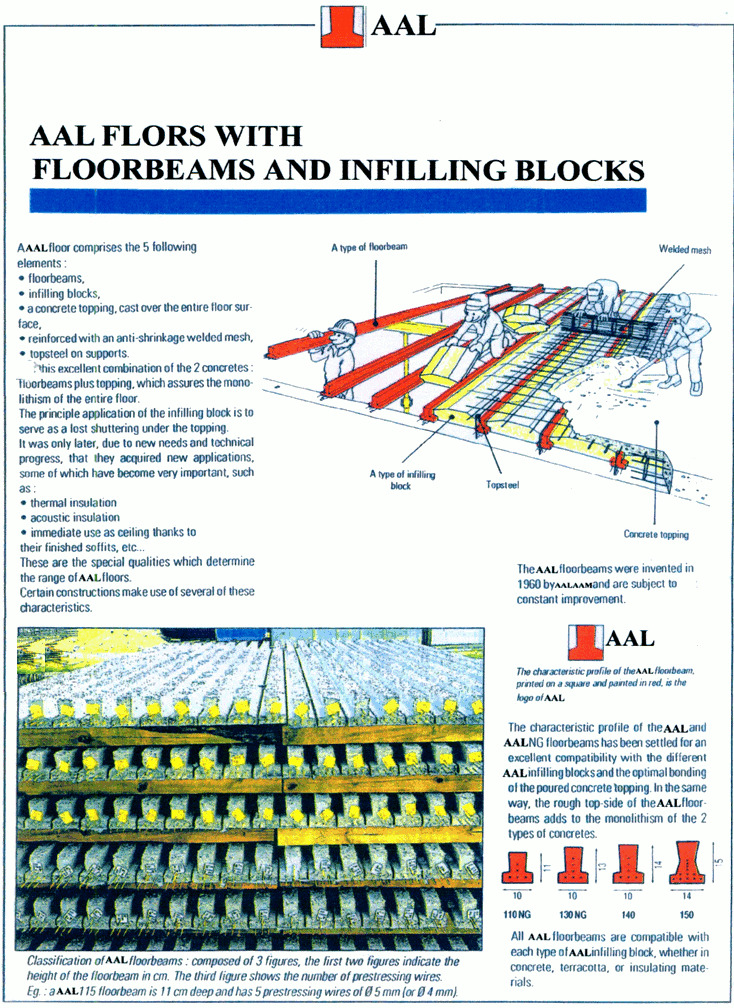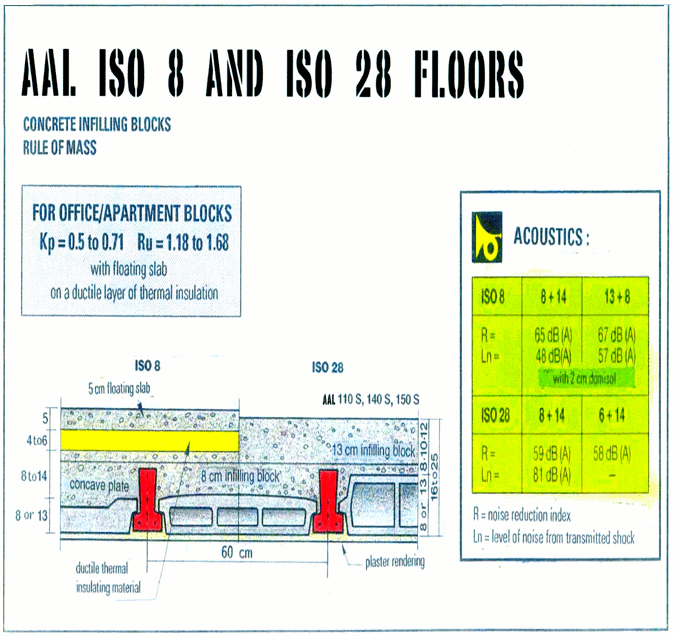System
of prefabricated concrete ceilings
- Complete
safety
- High quality
- Ease and
speed of implementation
- Big savings
in the costs of setting up all types of concrete struc tures for all
installations
Advantages
Lightness
The light weight of the buildings enables :
Less
material on site
The prefabrication of the components in the factory
reduces the amount of material on site :
-
No
shuttering .
-
Less
concrete.
-
Fewer
reinforcements.
-
Fewer props.
Rapid erection The simplicity of the components
and their assembly enables a saving in constructions time.
LARGE
RANGE OF EXTERIOR FACADES
Building with components enables the use of all types of
constructions and exterior facades.
QUALITY The factory controlled precasting ensures
strict and constant quality of the components .
SAFTEY Building with industrially prefabricated
components lowers the risks on site.
EASY ERECTION
The lightweight prefabricated components enables :
ASSEMBLY The simple project conception ensures
perfect cohesion on erection and adaptation to any architectural
project.
LESS CONCRETING ON SITE
The erection of components requires very little
concreting on site.
SAVINGS Wood : no shuttering
Steel : 1 to 5 times less than in reinforces concrete
Concrete : 1 to 2 times less than in reinforced concrete.
Less
expensive due to :
-
Use of
prestressing with steel rods.
-
Optimized
dimensions of the components.
-
Less
restricting tolerances.
-
Easy and
rapid erection.
It is
largely evident that the most economic way of building is to use a
combination of the least expensive aspects of both prefabricated and
traditional methods.
-
FOR THE
ARECHITECT
- Freedom
of
architectural concept .
- Thinner
(
prestressed ) beams and floor beams.
- Saving
in
floor thickness.
-
FOR THE
PROJECT MANAGER
- Assurance
of factory manufactured elements subjected to strict quality control.
- Very
few
reinforcing bars to be erected on site.
- Computerized
and standardized design and concepts ; calculations and plans are
computer prepared in the factory.
- Verification
done by the project manager contracted for the plans without him having
to carry them out.
-
FOR THE
CONTRACTOR
- NO
investment in shuttering for the floors and beams.
- Saving
in
construction costs:
- Neither
heavy handling equipment nor transport for materials.
- Reduction
in weight, thus reduction in posts and foundations .
- Rapid
erection with unskilled labour.
- Less
concrete due to the reduce thickness of the floors.
- Few
reinforcing bars to be used on site .
- Reduced
risk due to a strict quality control of products.
- Clean
and
easy site organization.
- Work
under
the floor is possible immediately after erection .
- Most
components are available ex-stock direct from the factory , ensuring
excellent price maintenance.
-
The
manufacture of the components is perceived from and industrial point of
view :
- Standardized
products .
- High
yield .
- Low
wastage
.
- Low
manufacturing costs in comparison with traditional methods .
- Good
profitability of investment .
- A
very
large market due to the products being adaptable to all types of
construction ,
- Highly
saleable products due to their many plus-features .
- Products
not " made to measure " but storable in most cases enabling a regular
production flow ( stocks absorb the overproduction ).
- The
advantages of a franchise system which enables the manufacturer to
benefit from the continual experience know-how and research of PPB
INTERNATIONAL support in all domains.
ADVANTAGES OF THE
COMPONENTS FOR ARECHITECTS,
CONSULTATS, CONTRACTORS, AND MANUFACTURES
The
research into cost reduction , reduction in erection time, has given
birth to a variety of concepts for prefabrication.
Most
concepts involve heavy , one-off manufacturing processes with
numerous disadvantages :
-
High
equipment investment,
-
Heavy
transport and handling methods,
-
One-off
systems for a single project for which all the elements are specially
defined,
-
Qualified
labour for specific jobs,
-
Large
scale components with inherent problems in assembly tolerances,
-
Problems
of site organization,
-
Usually
expensive due to large quantity of raw materials and difficulties to
pay off the factory.
THE
AALAAM
concept of widely
compatible components – the other way of doing it –
has
proved with success over the years that is was much closer to the
real needs of people involved with construction, Inevitably, the
following advantages arise:
-
Low
investment, and profitable exploitation for the investor,
-
No
heavy transport or components which can be used in almost every type of
architectural project without changing manufacturing equipment,
-
Simple
assembly methods,
-
No
problems of tolerances,
-
Very
easy site organization.



